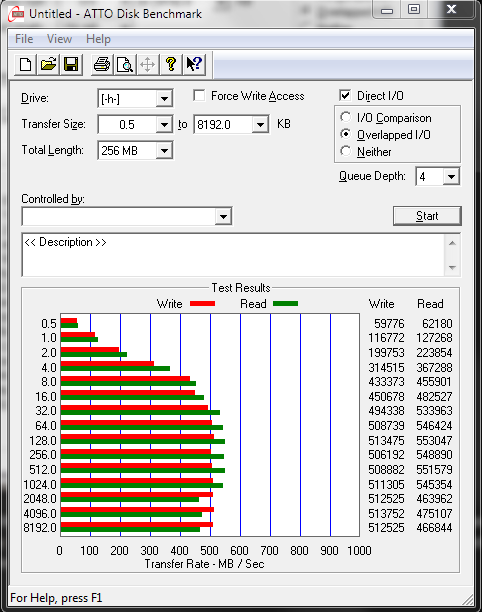ATTO Disk Benchmark is perhaps one of the oldest benchmarks going and is definitely the main staple for manufacturer performance specifications. ATTO uses RAW or compressible data and, for our benchmarks, we use a set length of 256mb and test both the read and write performance of various transfer sizes ranging from 0.5 to 8192kb. Manufacturers prefer this method of testing as it deals with raw (compressible) data rather than random (includes incompressible data) which, although more realistic, results in lower performance results.
ATTO performance of 551MB/s read and 510MB/s write match specifications very closely but, more importantly, notice how fast performance has picked up starting right at the 4K level with results of 367MB/s read and 314MB/s write transfer speeds. Whether or not this is the result of nCache cannot be confirmed, however, these are the most well rounded ATTO benchmark results we have seen to date. What this translates to is quicker visible start, system and application performance.
CRYSTAL DISK BENCHMARK VER. 3.0 X64
Crystal Disk Benchmark is used to measure read and write performance through sampling of raw (0/1 Fill/compressible) or random data which is, for the most part, incompressible. In the SanDisk Extreme II SSD, performance results are very similar whether we test with compressible or incompressible data and, for this reason, results are displayed utilizing incompressible data.
Once again, we are seeing very string results, although we cannot state that any 4K difference attributable to nCache can be seen here.
Up until recently, AS SSD was the only benchmark created specifically for SSD testing and it uses incompressible data. AS SSD, for the most part, gives us the ‘worst case scenario’ in SSD transfer speeds because of its use of incompressible data and many enthusiasts like to AS SSD for their needs. Once again, we will display the standard system on the left with optimized on the right.

 Attaining Total Scores of over 1000 in AS SSD is always nice but the high 4K IOPS of 90257 read and 71360 write really make this SSD shine. Copy benchmarks were also very good as we see here:
Attaining Total Scores of over 1000 in AS SSD is always nice but the high 4K IOPS of 90257 read and 71360 write really make this SSD shine. Copy benchmarks were also very good as we see here:
 The SSD Review The Worlds Dedicated SSD Education and Review Resource |
The SSD Review The Worlds Dedicated SSD Education and Review Resource | 

Finally a Marvell SSD with decent OP…about time!
Now that’s what i like to see!
Great performance up there with the top dogs!
That 4K numbers are on par with the summys!
Wait to see pricing here in Greece!
Thanks for the review!
where are your steady state benchmarks? testing for several hours under load? the other good review sites do it and its the only thing i look at. please add them!
Different sites have different methods of testing. Although we look very closely at steady state number for enterprise drives, we don’t feel this is a major factor with consumers. Our test methodology was determined after abreat deal of feedback with readers.
Hello, your Samsung 840 Pro 512GB SSD Review is dated September 24, 2012 and you gave it your Editor’s Choice award, with the final-awards-0211.png graphic.
The SanDisk Extreme II SSD Review on this page is dated June 26, 2013 and you also gave it your Editor’s Choice award, no graphic though. Which SSD currently has your Editor’s Choice award?
Thank you for pointing this out. The award seems to have vanished but will be back soonest.
Look at the current this thing draws: 1.6A at 5V would require two USB 3 ports or three USB 2 ports to power it in a portable case. It is only suitable for use in cases with external power or inside a computer.
And? Why would you expect otherwise.
SanDisk’s spec summary on their website says max write power is 5.0W (vs. 8), or 1A at 5V — still maybe a bit high. Typical “active” is spec’ed at 0.22W.